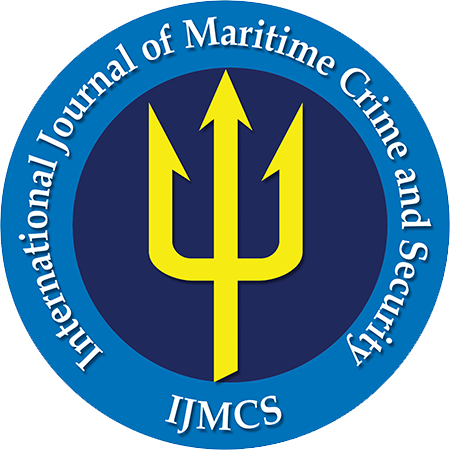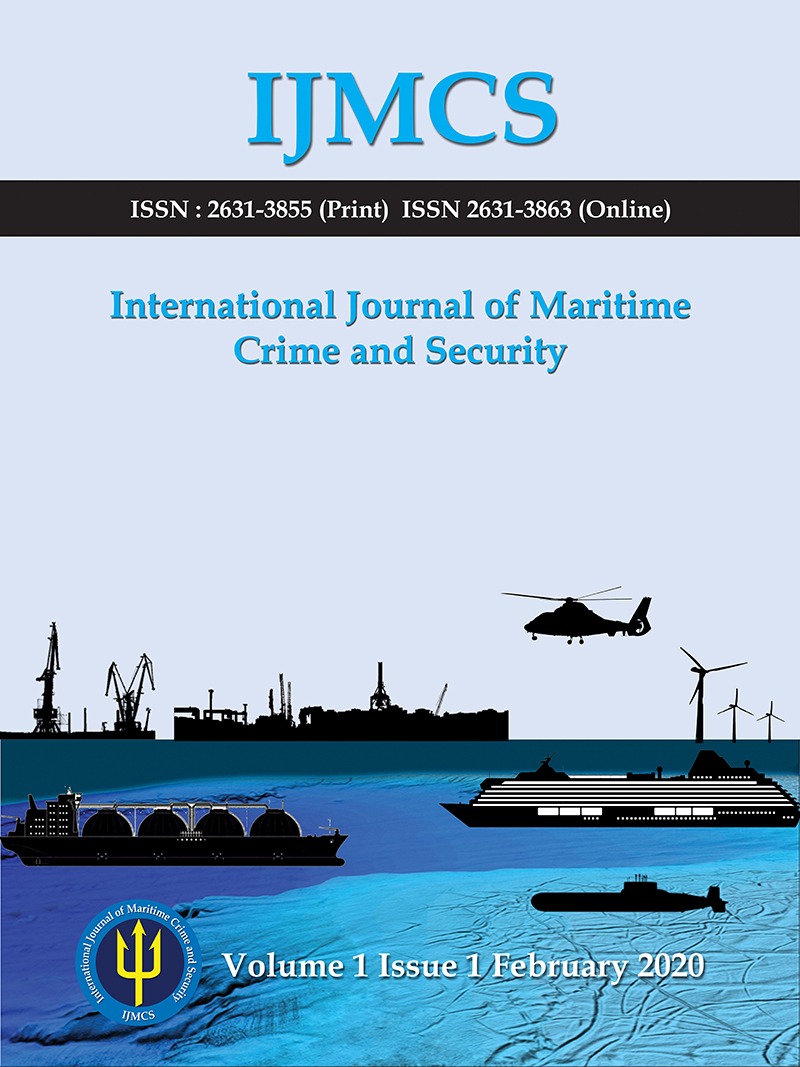Internal theft, maritime investigations, risk assessment, security, voice, artificial intelligence
Ever since criminal networks have recognized the profit in oil and energy pipelines, the theft of hydrocarbon-based products has jeopardized the stability and security of global regions. Although numerous pipelines run across land and below the oceans, tankers serve as the most efficient way of transporting crude oil and natural gas between continents. This applied research study describes a novel AI-powered, a voice-based tool that identified human risk in a multi-national Southeast Asian energy company weakened by large-scale internal theft. 78.6 percent of completed automated interviews resulted in risk-positive evaluations. Ground truth from testimonial interviews and an internal investigation verified 92.6 percent of scrutinized flags. Previously undiscovered details were identified by the automated tool regarding the scope, size, and scale of crime issues, involving all job levels and local politicians. Analyses provided evidence of the technology’s non-biased nature and demonstrated that its algorithm-generated outputs may be more dependable than observable behavioural cues. Findings (1) describe a potential decision support tool for detecting risk in situ, (2) contribute to employee fraud and internal theft literature, and (3) indicate that in the southeast Asian energy industry, approval for the approach described and recognition of its contribution are overwhelming.
Download Full Text Here
- American Bar Association Asian Law Initiative, ABA-ALI (2007). “Legal Ethics Manual.” Scribd. Scribd, 2007. Available at: https://www.scribd.com/doc/37897865
- Ambituuni, A. et al. (2015) “Risk assessment of a petroleum product pipeline in Nigeria: The realities of managing problems of theft/sabotage,” WIT Transactions on The Built Environment [Preprint]. Available at: https://doi.org/10.2495/safe150051.
- Brenner, M., Doherty, T. and Shipp, T. (1994). “Speech measures indicating workload demand.” Aviation, Space, and Environmental Medicine, 65, pp. 21-26. Available at: https://psycnet.apa.org/record/199420587001
- Brun, A., Trench, M. and Vermaat, T. (2018) Why oil and gas companies must act on analytics, McKinsey & Company.
- McKinsey & Company. Available at: https://www.mckinsey.com/industries/oil-and-gas/our-insights/wh
- oil-and-gas-companies-must-act-on-analytics.
- Brynjolfsson, E. and McAfee, A. (2017) “The Business of Artificial Intelligence,” Harvard Business Review, 24 June.
- Available at: https://hbr.org/2017/07/the-business-of-artificial-intelligence.
- Buchanan, B. (2005) “A (Very) Brief History of Artificial Intelligence.” AI Magazine. 26(4), pp. 53-60. Available at: https://ojs.aaai.org/index.php/aimagazine/article/view/1848
- Ching, M., Fabito, B. and Celis, N. (2018) “Data Privacy Act of 2012: A case study.” Advanced Science Letters, 24(10), pp. 7042–7046. Available at: https://www.researchgate.net/publication/327281053_Data_Privacy_Act_of_2012
- Chui, M. and Manyika, J. (2018) The real-world potential and limitations of Artificial Intelligence, McKinsey & Company.
- McKinsey & Company. Podcast. Available at: https://www.mckinsey.com/featured-insights/artificial
- intelligence/the-real-world-potential-and-limitations-of-artificial-intelligence.
- Cohen, J. (1988) Statistical Power Analysis for the behavioral sciences. Hillsdale, NJ: L. Erlbaum Associates.
- Collett, P. (2004) Book of tells. TRANSWORLD PUBLISHERS LTD.
- Cowen, A. et al. (2019) “Mapping 24 emotions conveyed by brief human vocalization.,” American Psychologist, 74(6),
- pp. 698–712. Available at: https://doi.org/10.1037/amp0000399.
- Dadpay, A. (2020) “An analysis of fuel smuggling in the Middle East as a single multinational market,” Journal of Industry, Competition and Trade, 20(4), pp. 643–656. Available at: https://doi.org/10.1007/s10842-020-00340-6.
- Dalby, C. (2014) 5 industries worried about Peak oil, OilPrice.com. Available at: https://oilprice.com/Energy/Crude Oil/5-Industries-Worried-About-Peak-Oil.html.
- Daugherty, A. (2014) Rising oil theft in Mexico points to collusion with foreign businesses, InSight Crime. Available at: https://insightcrime.org/news/brief/rising-oil-theft-points-to-criminal-collusion-with-foreign-businesses/.
- Dedovic, K. et al. (2009) “Neural correlates of processing stressful information: An event-related fmri study,” Brain Research, 1293, pp. 49–60. Available at: https://doi.org/10.1016/j.brainres.2009.06.044.
- Desjardins, J., Grandi, W.B.T.D. and Article & Editing Katie Jones (2017) Crude awakening: The global black market for oil, Visual Capitalist. Available at: https://www.visualcapitalist.com/global-black-market-fuel-theft/.
- Desjardins, J. (2017) Fuel theft is a big problem, Business Insider. Business Insider. Available at:https://www.businessinsider.com/fuel-theft-is-a-big-problem-2017-5.
- Desjardins, J., Grandi, W.B.T.D. and Article & Editing Katie Jones (2016) The oil market is bigger than all metal markets combined, Visual Capitalist. Available at: https://www.visualcapitalist.com/size-oil-market/.
- EPA. Environmental Protection Agency (2021) Types of Refined Petroleum Products. EPA. Available at: https://www.epa.gov/emergency-response/types-refined-petroleum-products.
- Ernst and Young (2014) Managing Bribery and Corruption Risks in the Oil and Gas Industry, EY. Available at: https://www.ey.com/Publication/vwLUAssets/EY-Managing-briberyand-corruption-risk-in-the-oil-and-gas-industry/$FILE/EY-Managing-bribery-and-corruption-risk-in-the-oil-and-gas-industry.pdf
- Ernst and Young (2018) Integrity in the Spotlight - the Future of Compliance 15th Global Fraud Survey. ReadkonG.com. Available at: https://www.readkong.com/page/integrity-in-the-spotlight-the-future-of-compliance-4216989
- Exploring the impact of artificial intelligence on offshore oil and Gas (2019). Available at: https://www.offshore technology.com/analysis/application-of-artificial-intelligence-in-oil-and-gas-industry/.
- Farrow, T. et al. (2013) “Neural correlates of the behavioral-autonomic interaction response to potentially threatening stimuli,” Frontiers in Human Neuroscience, 6(34), pp. 1-17. Available at: https://doi.org/10.3389/fnhum.2012.00349.
- Fiedler, K., Kutzner, F. and Krueger, J. (2012) “The long way from α-error control to validity proper,” Perspectives on Psychological Science, 7(6), pp. 661–669. Available at: https://doi.org/10.1177/1745691612462587.
- Frequently asked questions (FAQs) - U.S. energy information administration (EIA) (2021) Frequently Asked Questions (FAQs) U.S. Energy Information Administration (EIA). Available at: https://www.eia.gov/tools/faqs/faq.php?id=33&%3Bt=6.
- Gius, D. et al. (2018) Value and Resilience through Better Risk Management,” McKinsey & Company. McKinsey & Company. Available at: https://www.mckinsey.com.br/capabilities/risk-and-resilience/our-insights/value and-resilience-through-better-risk-management.
- Gordon, A. (2017) Father and son in scam to Syphon off £1m Hydrocarbon Fuel, Daily Mail Online. Associated Newspapers.Available at: https://www.dailymail.co.uk/news/article-4600722/amp/Father-son-scam-syphon-1m hydrocarbon-fuel.html.
- Gordts, E. (2014) How ISIS is using oil to fund its Terror, HuffPost. HuffPost. Available at: https://www.huffpost.com/entry/isis-oil_n_5877008.
- Greenleaf, G. (2014) Asian data privacy laws-trajectories, lessons, and optimism, OUP Academic. Oxford University Press. Available at: https://doi.org/10.1093/acprof:oso/9780199679669.003.0020.
- Hadjicostis, M. et al. (2020) Cyprus blasts 'pirate state' Turkey's new gas drilling bid, The Times of Israel. Available at: https://www.timesofisrael.com/cyprus-blasts-pirate-state-turkeys-new-gas-drilling-bid/.
- Hansen, J.. and Patil, S. (2007) “Speech under stress: Analysis, Modeling and Recognition,” Lecture Notes in Computer Science, pp. 108–137. Available at: https://doi.org/10.1007/978-3-540-74200-5_6.
- Hardoon, D. and Heinrich, F. (2011) Bribe payers index 2011 - publications, Transparency.org. Available at: https://www.transparency.org/en/publications/bribe-payers-index-2011.
- Hoadley, D. and Sayler, K. (2020) Artificial Intelligence and National Security, CRS Report R45178. 2020.
- Available at: https://crsreports.congress.gov/product/pdf/R/R45178/5
- Hubculture (2018) Hub culture Davos 2018 - Rita Singh, Research Faculty at Carnegie Mellon University, YouTube. YouTube. Available at: https://www.youtube.com/watch?v=wvGP8I5UhHk.
- Hughes, C. (2017) The ellipsis manual: Analysis and engineering of human behavior. Virginia Beach, VA: Evergreen Press.
- Jones, N. and Sullivan, J. (2019) “Huachicoleros: Criminal cartels, fuel theft, and violence in Mexico,” Journal of Strategic Security, 12(4), pp. 1–24. Available at: https://doi.org/10.5038/1944-0472.12.4.1742.
- Junoh, A.K. et al. (2013) “Crime detection with DCT and artificial intelligent approach,” Advanced Materials Research, 816-817, pp. 610–615. Available at: https://doi.org/10.4028/www.scientific.net/amr.816-817.610.
- Kaminski, P. and Schonert, J. (2017) The neglected art of risk detection, McKinsey & Company. McKinsey & Company. Available at: https://www.mckinsey.com/business-functions/risk-and-resilience/our-insights/the-neglectedart-of-risk-detection.
- Kemshall, H., Mackenzie, G. and Wilkinson, B. (2011). “6.1.2 False Positive and False Negatives in Risk
- Assessments.” 6 Best Practice and Avoiding Errors | ROH V4.36. Risk of Harm Guidance and Training Resources. Available at: http://www.nomsintranet.org.uk/roh/roh/6-best_practice/06_01_02.htm
- Khartukov, E. (2021) Oil theft: A frightening international perspective – Oilman Magazine. Available at: https://oilmanmagazine.com/article/oil-theft-a-frightening-international-perspective/
- Khuwaja, K.et al. (2018) “Automatic fuel tank monitoring, tracking and Theft Detection System,” ANNALS OF THE ORADEA UNIVERSITY. Fascicle of Management and Technological Engineering., Available at: https://doi.org/10.15660/auofmte.2018-1.3333.
- Knight, W. (2020) Ai is all the rage. so why aren't more businesses using it?, Wired. Conde Nast. Available at: https://www.wired.com/story/ai-why-not-more-businesses-use/.
- Laukka, P. et al. (2008) “In a nervous voice: Acoustic analysis and perception of anxiety in social phobics’ speech,” Journal of Nonverbal Behavior, 32(4), pp. 195–214. Available at: https://doi.org/10.1007/s10919-008-0055-9.
- Lepcha N., Sherpa, T. and Tamang, J. (2015). “GSM Based Fuel Theft Detector Using Microcontroller.” International Journal of Advance Electrical and Electronics Engineering 4(3), pp. 7-12. ISSN: 2278-8948.
- MacNamee, G. (2015) Fuel smuggling: Thugs taking courses on how to remove dye from Diesel, Irish Mirror. Available at: https://www.irishmirror.ie/news/irish-news/crime/fuel-smuggling-thugs-taking-courses-5599589.
- Martin, A., Zaal, J., Azevedo, M., and Dutra, C. (2021). A Novel Decision Support Risk Assessment Tool for Investigating Internal Theft in a Gaming Establishment: A Case Study. International Journal of Gaming Hospitality and Tourism. 1(1), pp. 1-20. Available at: https://ojs.stockton.edu/index.php/light/article/view/20/3
- Mendoza, E. and Carballo, G. (1998) “Acoustic analysis of induced vocal stressby means of cognitive workload tasks,” Journal of Voice, 12(3), pp. 263–273. Available at: https://doi.org/10.1016/s0892-1997(98)80017-9.
- Meyer, M., Roodt, G. and Robbins, M. (2011) “Human Resources Risk Management: Governing people risks for improved performance,” SA Journal of Human Resource Management, 9(1), pp 1-12. Available at: https://doi.org/10.4102/sajhrm.v9i1.366.
- Mooring lines sample clauses (2021) Law Insider. Available at: https://www.lawinsider.com/clause/mooring-lines.
- Muehlhan, M. et al. (2013) “Enhanced sympathetic arousal in response to fmri scanning correlates with task induced activations and deactivations,” PLoS ONE, 8(8), pp. 1–11. Available at: https://doi.org/10.1371/journal.pone.0072576.
- Murphy, K., Myors, B., and Wolach, A. (2014) Statistical Power Analysis: A simple and general model for traditional and modern hypothesis tests. London, England: Routledge.
- Navarro, J. and Karlins, M. (2015) What every body is saying: An ex-FBI agent's Guide to Speed-reading people. New York,NY: Harper Collins.
- NI Business Info (2020) Risks and limitations of artificial intelligence in business. Available at: https://www.nibusinessinfo.co.uk/content/risks-and-limitations-artificial-intelligence-business.
- Nierenberg, G., Calero, H. and Grayson, G. (2010) How to read a person like a book: Observing body language to know what people are thinking. Garden City Park, NY: Square One Publishers.
- Nazarova, A. (2019) Dark world of oil theft and fraud, Fraud Magazine. Available at: https://www.fraud magazine.com/article.aspx?id=4295006268.
- Noyan, B. (2021) Global 500 2016, Fortune. Fortune. Available at: https://fortune.com/global500/2016/.
- Olchondra, R. (2014) With oil smuggled in, gov't waves tax revenues goodbye, INQUIRER.net. Available at:https://business.inquirer.net/165510/with-oil-smuggled-in-govt-waves-tax-revenues-goodbye.
- Osborne, J. (2020) Can fuel theft be stopped once and for all? Houston Chronicle. Houston Chronicle. Available at: https://www.houstonchronicle.com/business/energy/article/Can-fuel-theft-be-stopped-once-and-for-all15277830.php.
- Quest, L. et al. (2018) The risks and benefits of using AI to detect crime, Harvard Business Review. Available at: https://hbr.org/2018/08/the-risks-and-benefits-of-using-ai-to-detect-crime.
- Ralby, I. (2020) Downstream oil theft, Atlantic Council. Available at: https://www.atlanticcouncil.org/programs/global energy-center/downstream-oil-theft/.
- Rigano, C. (2018) Using artificial intelligence to address criminal justice needs, National Institute of Justice. Available at: https://nij.ojp.gov/topics/articles/using-artificial-intelligence-address-criminal-justice-needs.
- Robson, C. and McCartan, K. (2016) Real World Research. Chichester: Wiley.
- Scherer, K. (2003) “Vocal Communication of Emotion: A review of research paradigms,” Speech Communication, 40(12), pp. 227–256. Available at: https://doi.org/10.1016/s0167-6393(02)00084-5.
- Sharik, N., Chaitanya, D. and Shankar, L. (2019) “Fuel Level Monitoring & Alert System using IOT,” International Journal of Engineering and Advanced Technology, 8(652), pp. 525–527. Available at:https://doi.org/10.35940/ijeat.f1153.0886s219.
- Simon-Thomas, E. et al. (2009) “The voice conveys specific emotions: Evidence from vocal burst displays.,” Emotion, 9(6), pp. 838–846. Available at: https://doi.org/10.1037/a0017810.
- Singh, R. (2019) Profiling humans from their voice. Singapore: Springer.
- Snežana, B. (2001). "The declaration of Helsinki: The cornerstone of research ethics". Archives of Oncology. 9(3): pp. 179–184. Available at: http://www.onk.ns.ac.rs/Archive/Vol9/PDFVol9/V9n3p179.pdf
- Sondhi, S. et al. (2015) “Vocal indicators of emotional stress,” International Journal of Computer Applications, 122(15), pp. 38–43. Available at: https://doi.org/10.5120/21780-5056.
- Soud, D. (2020) Downstream oil theft: Countermeasures and good practices, Atlantic Council. Available at: https://www.atlanticcouncil.org/in-depth-research-reports/report/downstream-oil-theft-countermeasures and-good-practices/.
- Suchotzki, K. et al. (2017) “Lying takes time: A meta-analysis on reaction time measures of deception.,” Psychological Bulletin, 143(4), pp. 428–453. Available at: https://doi.org/10.1037/bul0000087.
- Terzian, R. et al. (2020) “CCPD: A reactive information system to prevent fuel theft in oil pipelines,” Rio Oil and Gas Expo and Conference, 20(2020), pp. 433–434. Available at: https://doi.org/10.48072/2525-7579.rog.2020.433.
- Throckmorton, C. et al. (2015) “Financial fraud detection using vocal, linguistic and financial cues,” Decision Support Systems, 74, pp. 78–87. Available at: https://doi.org/10.1016/j.dss.2015.04.006.
- Tselyutina, T., and Vlasova, T. (2019). “Development of the Personnel Risks Assessment and Supply Chain Strategy as a Basis of the Risk Management System of Modern Organizations.” International Journal of Supply Chain Management, 8(5), pp. 1030-1038. ISSN: 2050-7399.
- Van Puyvelde, M. et al. (2018) “Voice stress analysis: A new framework for voice and effort in human performance,” Frontiers in Psychology, 9. Available at: https://doi.org/10.3389/fpsyg.2018.01994.
- Verschuere, B. et al. (2018) “Taxing the brain to uncover lying? meta-analyzing the effect of imposing cognitive load on the reaction-time costs of lying.” Journal of Applied Research in Memory and Cognition. Available at: https://doi.org/10.31219/osf.io/uqvkt.
- Wang, Z. et al. (2020) “The development trend of internal combustion engine,” Journal of Physics: Conference Series, 1626(1), pp. 1–5. Available at: https://doi.org/10.1088/1742-6596/1626/1/012139.
- Williams, C. and Stevens, K. (1972) “Emotions and speech: Some acoustical correlates,” The Journal of the Acoustical Society of America, 52(4B), pp. 1238–1250. Available at: https://doi.org/10.1121/1.1913238.
- World Economic Forum (2018) Pinpointing people and places through Advanced Audio Analysis | Rita Singh, YouTube. YouTube. Available at: https://www.youtube.com/watch?v=4HjcQjwKBWM.



